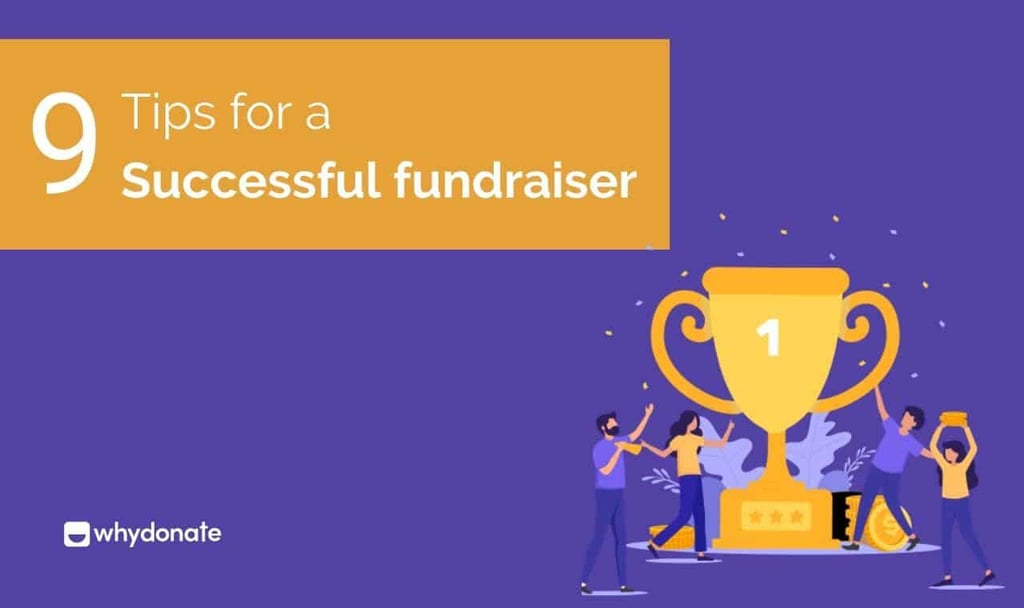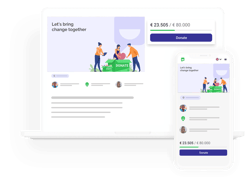When talking about fundraising campaigns and all the challenges that come with it, fundraisers all agree on one thing, and nothing is more courageous than personally asking for donations. However, asking someone personally for a donation has many benefits compared to other fundraising techniques, such as crowdfunding.
Table of Contents
What Makes A Successful Fundraising Campaign?
There can be many reasons for using the pro tips for a successful fundraising campaign, but fundraising experts see the following a lot:
- Meeting someone personally as a fundraiser can help to build a relationship with them, a future donor, in a way that no fundraising campaign or technique can do.
- One-on-one interaction enables a personal approach.
- The agreement to meet someone in person already indicates that this person is interested in donating.
- It’s a lot harder to say ‘no’ in person.
How To Start A Fundraising Campaign?
1. Make Sure You Get The Basics Right
Don’t start work haphazardly with a (personal) fundraising campaign. This can lead to you wasting valuable resources of the organisation which could have been used better elsewhere.
First of all, you need to have a clear general context. Take your time to read up on the mission, vision, and goals of your organisation, after which you should look at your fundraising campaign as a whole. What do you hope to achieve with your fundraising campaign? What is your general target or goal? Who will benefit from your fundraising campaign?
How much money will you need to raise, or how many donors will you need to bring in?
Have a look at previous fundraising campaigns and the outcomes. This will help you to set realistic targets.
Additionally, make a detailed overview of the costs attached to your fundraising campaign, such as finances, time of employees, marketing and promotion, supplier contracts, start-up costs, and so on. Always make sure you include extra money in your budget for innovation and unexpected costs. Keep your employees and their skills in mind.
This will help you to get the basics right, which in turn will make sure that your fundraising campaign will have the intended impact and use for your non-profit organisation. It will also help you to establish the scope of the campaign.
On fundraisingcoach.com Marc A. Pitman says: “One of the most useful support tools is a donation grid, you can find an online free version on GiftRangeCalculator.com. Years of experience have taught me that you need at least one donation which will match 10% of your total target. The next two should match 5% of your total target and so on. If your target is to raise €100.000 you will need at least one donor who will give a donation of at least €10.000. Experience has also shown that you will need at least 4 or 5 potentials to bring these donations in. Work with the grid until you have names of potential people for each level.”
Learn more about setting and achieving Fundraising Goals
2. Research, Research, Research
It’s very important to do your research before you kick off with your best small talk.
Create a list of potential people and start with adding people you know to this list, for example, board members and their networks. Make a list of both people and companies. Start with the people whom you think have the capacity, are philanthropic, and/or are interested.
After that, do some research on the people and companies you have included in your lists for your fundraising campaign. You can use software to screen wealthy people, this way, you find out quickly whether or not they are able to donate to your organisation and, if they can, how much. Have they donated in the past? If so, which organisations did they donate to and how much? Do they know about your organisation, and are they interested in the same social topics as you?
Based on this research, you can prioritise your potential donors and prioritise your efforts for your fundraising campaign.
Once you have your top 10/50/100 potential people (depending of course, on the size of your organisation), you can delve deeper into your top people. Learn as much as possible about them by reading their blogs, biographies, or interviews.
3. Prepare Your Pitch
Outstanding personal fundraising isn’t about practising that presentation or memorising that speech by heart.
However, it does help to know your own value proposition. If you’re clear about why the work your organisation does matters, why it’s unique, and why someone should be interested in donating something, it can help when nerves pop up during your meeting.
Even though most people will donate on impulse during a fundraising campaign, they will still need concrete information to make big decisions (and personal fundraising is usually aimed at bigger donations).
Therefore, talk about the impact your organisation will make on the people you will help. Choose one or two case studies to sketch an image and then share the numbers.
For example:
Anna completed our programme a year ago. Now she is sober and runs her own flower shop.
She is only one of hundreds of young people we have helped, 800 in the past year to be precise, in Portland.
You can also consider giving a short explanation about your current strategic partnerships. Use the information you have gathered in your research to make your pitch personal. This will help the potential donor feel included.
Last but not least, asking for personal donations is also a two-way conversation. Never let your prepared speech or pitch be the central topic of the meeting. Conversations should flow naturally, so listen actively and participate in the conversation. Change what and how you say things depending on the conversation you’re having with the potential donor.
4. Practice Makes Perfect
Nothing new and exciting here; this is, of course, common knowledge: practice makes perfect. By the time you meet your potential donor, you will have practised your pitch and brushed off your skills.
Understand the topics you will be talking about and your most important value propositions. Play devil’s advocate and make a list of the most common objections you may encounter and practice how you can deal with them. Decide how you will amend the question when it comes up. With this in mind, you can be more focused and present during your meeting with your potential donor.
Ask your colleagues for feedback. Read more about negotiations, sales, verbal and non-verbal communication, and persuasion. Practice in front of the mirror. Film yourself and watch the recording back. Pay attention to things you could do differently.

5. Remain Focused On Your Posture
When you’re asking for donations in person, the outcome will also depend on how you come across as a person, contrary to other fundraising techniques.
Pay special attention to your body language and voice. Sit up tall and straight but relaxed, and face your potential donor. Use your body language to generate interest.
As for your voice, make sure you have a varied pace, pitch, and volume. It’s a good idea to mirror someone’s body language and use a similar verbal style, as this will create an emotional bond with your potential donor. Clear body language is relaxed and precise without holding back or controlling too much. Body language, for example, can support important points you’re making, and it should never contradict what you’re saying.
Lastly, a positive attitude is important in fundraising. If you enter a meeting thinking you will get a ‘no’, you’re much more likely to get one. Go to a meeting expecting to get a “yes” and ask for it.
6. Get Used To Rejection
Although it’s of vital importance that has a positive attitude and gets a “yes” when asking for personal donations, it’s also important to prepare for receiving a “no”.
This doesn’t mean that you should expect to get a “no”, but you should be prepared for it just in case.
It’s important for entrepreneurs, salespeople, and fundraisers to grow resilience and persistence if they eventually want to succeed.
Fundraising, like sales, is all about staying positive after hearing 10 times “no” until you will eventually get a “yes”.
Even if a potential donor tells you “no”, always thank them for their time. Also, try to understand why they have said “no” and, if necessary, ask them for feedback on the meeting and your performance during this. Take this feedback in, and keep improving your questions.
Moreover, ask them when would be a good time to get in touch with them again to re-evaluate the situation. Stay in touch with them but respect their wishes, and most of all, don’t harass them.

7. Be Interested
Anybody who has ever been successful in fundraising has been able to build meaningful relationships. You can’t build a meaningful relationship if you’re not interested in the other person.
Keep a few questions in your back pocket that came forward during your research. Perhaps you will ask your potential donors about their careers, plans for the future, projects, or things they are involved in. Listen without interrupting and ask questions, this shows them you’re listening.
When listening to long conversations, it’s important to concentrate and remember keywords and sentences.
When it’s your turn to listen, don’t spend this time trying to think ahead of what you will say afterwards. Of course, if you don’t understand something, you will need to ask the speaker for clarification. But don’t interrupt, wait until the speaker has finished talking.
If you want to be able to be empathetic, you need to be able to put yourself in the other person’s shoes and to allow yourself to imagine how they are feeling at that moment in time.
Show that you understand what the speaker is talking about by reflecting the feelings of the speaker. “You must have been very excited!”. “That must have been difficult.” “I can see you’re unable to make a decision”. Nod once in a while, smile, and use other facial expressions. Make sure your posture is open and interested.
Tip from an expert: don’t be scared of silence. Most of us feel very uncomfortable when there is silence, and we will do everything we can to keep a conversation going. However, if you pause after you have said something or after you confirmed something the potential donor has said, it will allow you to share more. This, in turn, will provide you with valuable information which you can use to keep the conversation going.
8. Ask The Question Eventually
You did everything you could… you did your research, you set up a meeting, you had the conversation, and you shared part of the work you did. The moment is there, and you start to panic. You have no idea how you can really ask the question. At this moment in time, temptation will be big to keep it vague, vague is more comfortable.
You could ask, “I was wondering if you would like to support our work” or “we could really use your help with this new project”. “support” and “help” aren’t specific enough though and can be interpreted very differently by different people.
Instead, you should ask:
“Would you like to consider a donation of €10.000?”
Always ask for a specific amount to support the cause. Don’t let your donor guess, take that burden away from them. You could even link that donation to a specific result.
Have a look at this example which Joan Garry shared on her blog:
“Would you like to make a donation of €489? I know this is a bit of an odd number but it happens to be the number of phone calls our help desk received last week. Can I count you in?”
If you get nervous, remember people will feel good when they’re donating to causes they care about and you’re thinking of resources to support projects and programmes which will change the world!

9. Don’t Forget To Say ‘Thank You’
Whether the donor has made a donation or not, your work isn’t over yet! Make sure you communicate to them how much you appreciate their donation or time. Thank them sincerely or in person.
Send them a personalised, handwritten letter to thank them after you have received their donation. Stay in touch with the donors through phone calls, emails, and social media. Mark your donors in your yearly report or somewhere on your website (after you have asked their permission, of course).
Invite the donor to meet your team, invite them to events, and try to keep meeting each other in person to thank them for their support.
By doing this, you will show your appreciation and you show your donor you really appreciate their support. By maintaining and building on the relationship with the donor, you show them that they mean more to you than just a money source.
When donors feel appreciated, invite them to support your organisation more and longer-term. They will probably also suggest other people.
Extra Tips To Get Donations
- Use all sorts of materials (such as videos, business cards, brochures, images, and even graphs) to add credibility.
- If they say “no”, offer them another way in which they can support you. Ask them if they know anyone who can help out at this moment in time or if they can share your non-profit organisation on social media.
- Slow down and take a deep breath, especially if you’re nervous.
- Ask someone who benefits from your service for a review.
- When you’re telling a story of a recipient, use their name, job, or hobbies. This will help potential donors to get to know them or get in touch with them.
- Consider inviting a potential donor for a conversation first to tell them about what you do and tell about the potential for voluntary work before you ask for money.
Your Turn
Asking for personal donations is an art in itself. Personally, asking for donations is easier for some than for others. Becoming an outstanding fundraiser takes years of perfecting your trade.
To be able to personally ask for donations, you should overcome the fear of rejection, failure, and not being good enough. It requires a willingness to fail and the courage to try again. It requires a willingness to learn whilst constantly looking for work. You’ll need to find your own authentic style of fundraising. And last but not least, but maybe most important of all, you need to love what your organisation does in the world!
At WhyDonate, our aim is to make your non-profit experience as productive as possible. You can do this now through our online donation system or through resources on our blog about non-profit organisations.
Ready to start your fundraising journey? Sign up here.



















